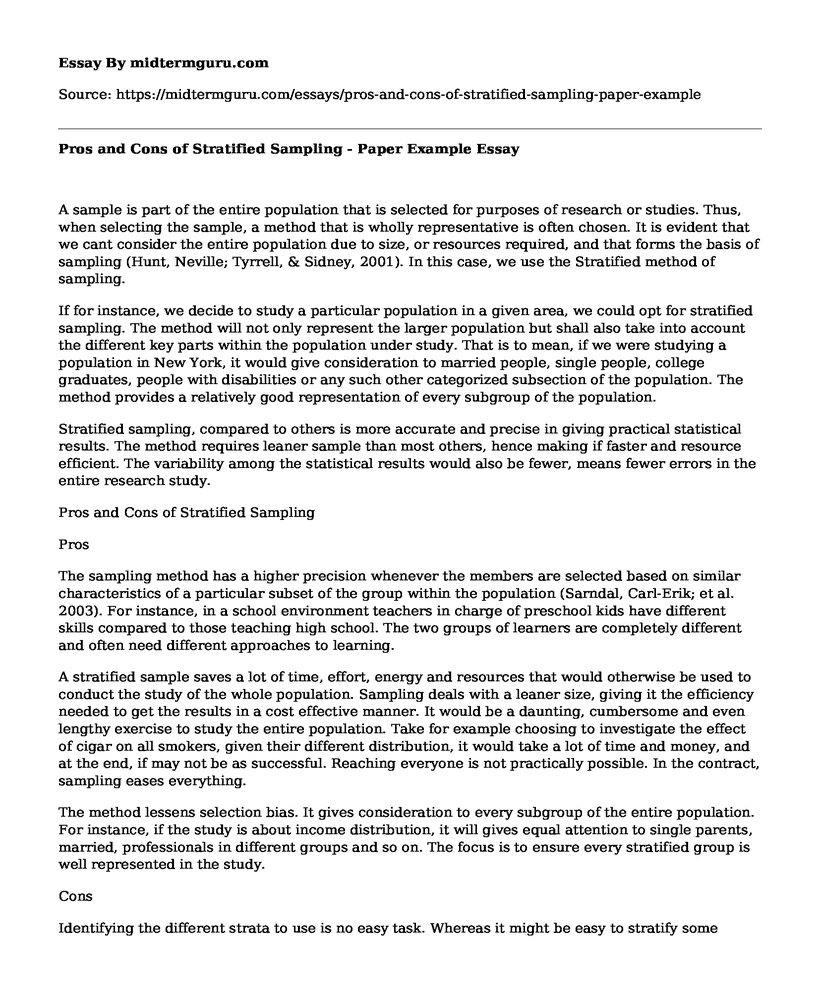A sample is part of the entire population that is selected for purposes of research or studies. Thus, when selecting the sample, a method that is wholly representative is often chosen. It is evident that we cant consider the entire population due to size, or resources required, and that forms the basis of sampling (Hunt, Neville; Tyrrell, & Sidney, 2001). In this case, we use the Stratified method of sampling.
If for instance, we decide to study a particular population in a given area, we could opt for stratified sampling. The method will not only represent the larger population but shall also take into account the different key parts within the population under study. That is to mean, if we were studying a population in New York, it would give consideration to married people, single people, college graduates, people with disabilities or any such other categorized subsection of the population. The method provides a relatively good representation of every subgroup of the population.
Stratified sampling, compared to others is more accurate and precise in giving practical statistical results. The method requires leaner sample than most others, hence making if faster and resource efficient. The variability among the statistical results would also be fewer, means fewer errors in the entire research study.
Pros and Cons of Stratified Sampling
Pros
The sampling method has a higher precision whenever the members are selected based on similar characteristics of a particular subset of the group within the population (Sarndal, Carl-Erik; et al. 2003). For instance, in a school environment teachers in charge of preschool kids have different skills compared to those teaching high school. The two groups of learners are completely different and often need different approaches to learning.
A stratified sample saves a lot of time, effort, energy and resources that would otherwise be used to conduct the study of the whole population. Sampling deals with a leaner size, giving it the efficiency needed to get the results in a cost effective manner. It would be a daunting, cumbersome and even lengthy exercise to study the entire population. Take for example choosing to investigate the effect of cigar on all smokers, given their different distribution, it would take a lot of time and money, and at the end, if may not be as successful. Reaching everyone is not practically possible. In the contract, sampling eases everything.
The method lessens selection bias. It gives consideration to every subgroup of the entire population. For instance, if the study is about income distribution, it will gives equal attention to single parents, married, professionals in different groups and so on. The focus is to ensure every stratified group is well represented in the study.
Cons
Identifying the different strata to use is no easy task. Whereas it might be easy to stratify some populations like people, it is not easy to do the same in some, for example animals. People can engage you; you can ask them questions which will enable you to put them into groups. The same is not available in animals, and stratifying them can be quite complicated. It is tough to identify the appropriate strata for a study because sorting each member of the population into a single layer accurately is not easy.
Stratified sampling cannot be used when the population cannot be exhaustively partitioned into disjoint subgroups (Sarndal et al., 2003). Disjoint groups, in this case, means into groups that do not have any similarity. That from a very literally point of view is not even possible. In some way, the members of the subgroups will have some similarities which end up making the data a bit inaccurate. For example, its not that simple to put a whole population into distinct ethnicities, or religious affiliations. Chances of making errors, either through misinformation through participants or even complete rejection to participate in the study are significant. That poses a massive challenge to the accuracy of the end results.
Sample size
Stratified means layers so to make a stratified sample, data is put into layers based on similar characteristics. A sample, on the other hand, is a part of the total population. To select a sample, we have known some things particularly budget, time and such other issues. After that, the most useful sample can be obtained. Choosing a sample size consisting of 1000 members can be more appropriate in most research studies.
With that sample figure, its easy to determine the exact difference in the populations under study. Taking samples to high, or too small can easily compromise the accuracy of the results. It is therefore essential that a right sample size is taken to improve the accuracy of the end results. It may also undermine the optimal use of resources if the sample size is too big, or too small.
References
Hunt, Neville; Tyrrell, Sidney (2001). "Stratified Sampling". Webpage at Coventry University. Archived from the original on 13 October 2013. Retrieved 12 July 2012.
Sarndal, Carl-Erik; et al. (2003). "Stratified Sampling". Model Assisted Survey Sampling. New York: Springer. pp. 100109. ISBN 0-387-40620-4.
Cite this page
Pros and Cons of Stratified Sampling - Paper Example. (2021, Jul 02). Retrieved from https://midtermguru.com/essays/pros-and-cons-of-stratified-sampling-paper-example
If you are the original author of this essay and no longer wish to have it published on the midtermguru.com website, please click below to request its removal:
- Paper Example: Data Management, Standards Development, and Access
- Implementation of the Cyber Security Plan in the Electronic Health Systems
- Background of the Kinetic Monte Carlo Method and a Description of the Catalyst Method
- Paper Example on Security Goals: Response to Threats and Safeguards That All Companies Need
- Sony's Financial Data: Assets, Liabilities, Cash Flow & More - Essay Sample
- Retailers Leverage Technology to Stay Ahead - Essay Sample
- Infrastructure: Barrier to E-Commerce Growth & Development - Essay Sample







